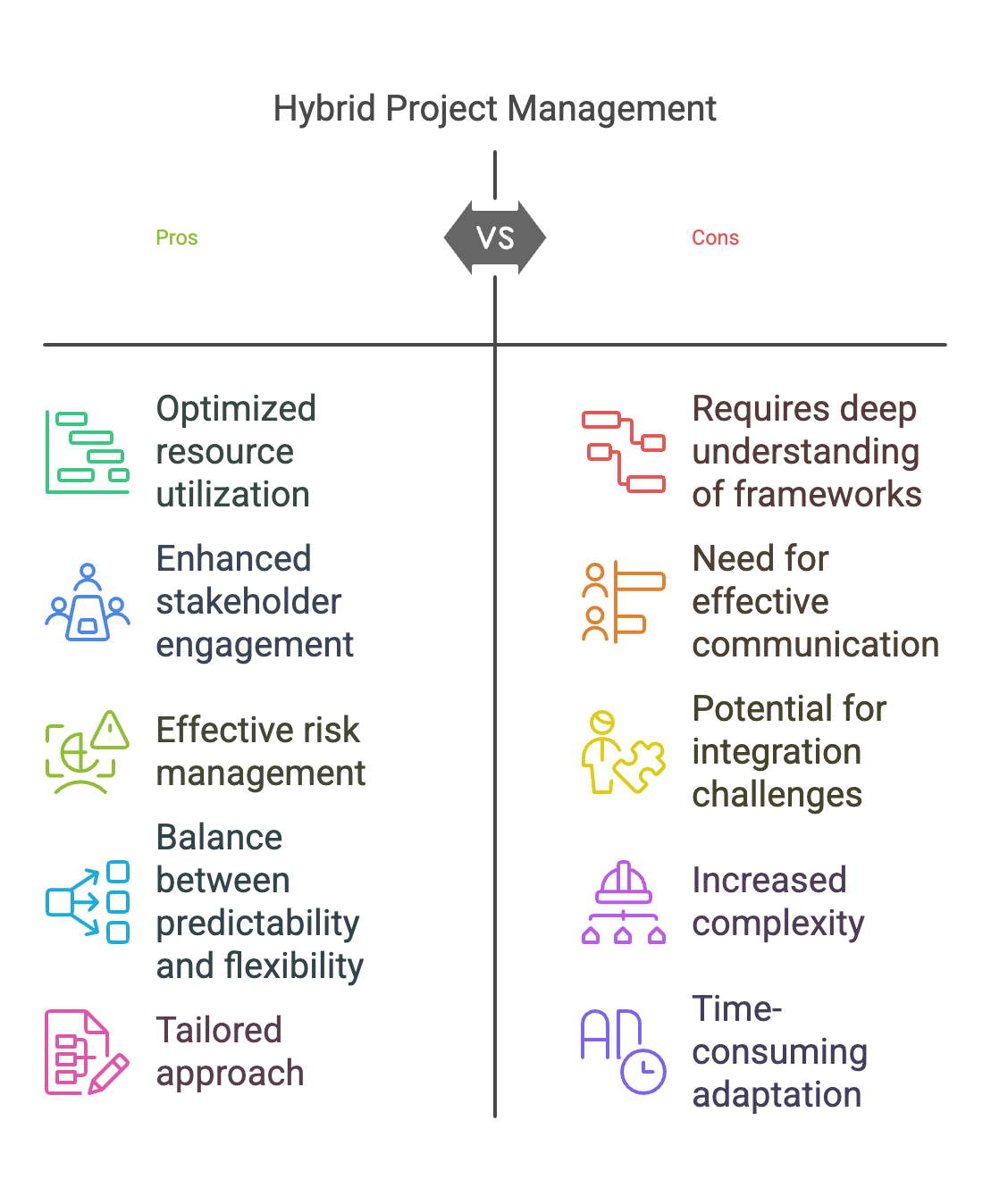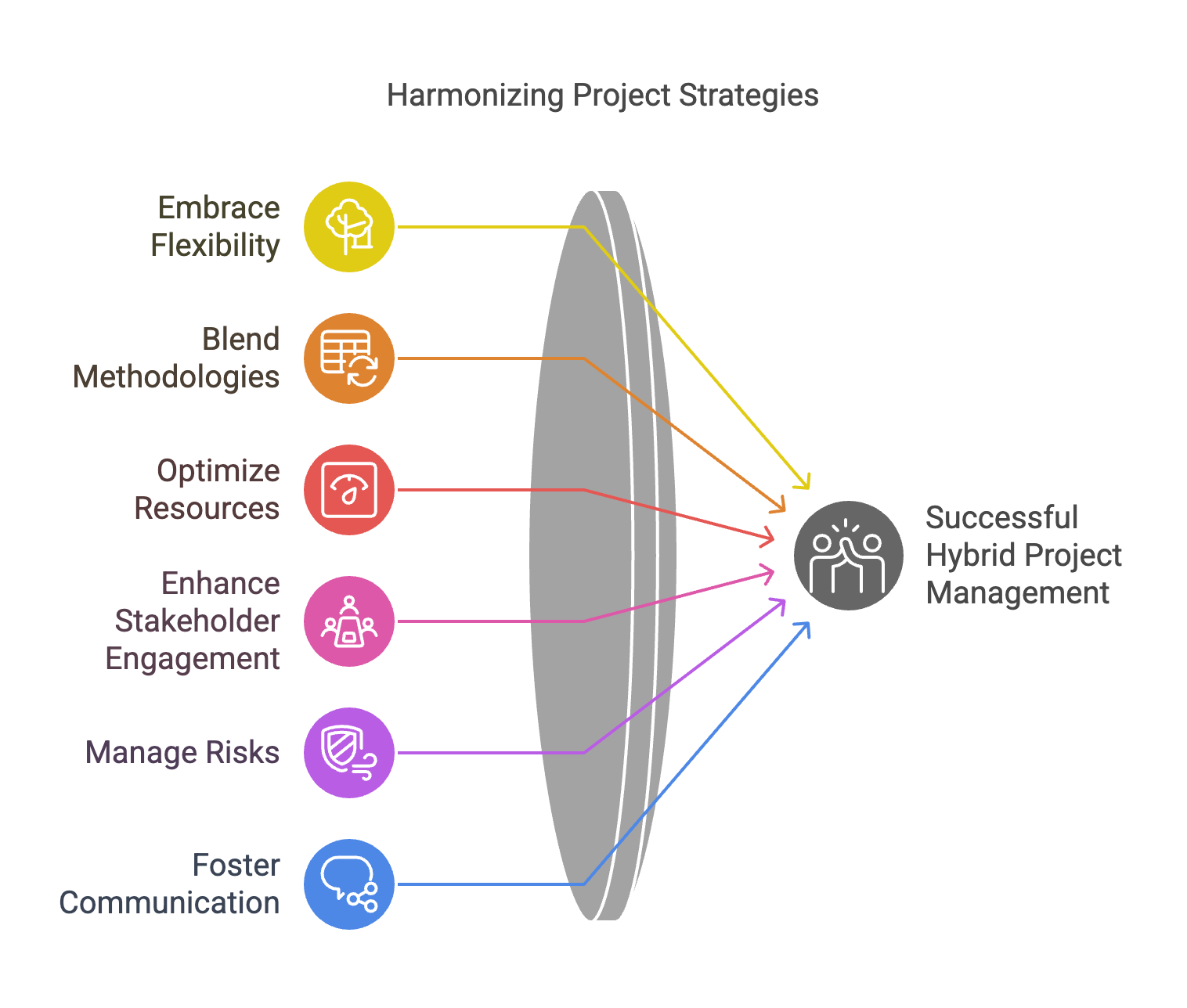Project management professionals have come to realize that a one-size-fits-all strategy may not always be the ideal option for dealing with every project, despite the popularity of methodologies like Waterfall and Agile. Thus, emerges the significance of new approaches like Hybrid Project Management—a flexible and adaptable framework that embraces the dynamic nature of the business environment.
Hybrid Project Management in a Nutshell
Hybrid Project Management is exactly as its name implies: a fusion of different frameworks and methodologies tailored to suit the unique needs of each project. It acknowledges that every project possesses its own distinct characteristics and requirements. By embracing this concept, Hybrid Project Management empowers project managers to customize their approach, thereby optimizing outcomes.
Throughout their careers, experts have encountered numerous projects that would have greatly benefited from the fluidity of Hybrid Project Management. While the traditional Waterfall approach thrives in situations with stable and predictable requirements, such projects are becoming increasingly rare in today's fast-paced world.
On the other hand, Agile, with its iterative and incremental approach, finds success in projects with evolving or uncertain requirements. However, strict adherence to Agile principles may not be the most efficient path for certain projects. Herein lies the beauty of Hybrid Project Management—it allows project managers to blend methodologies, creating a harmonious balance between predictability and adaptability.
With Hybrid Project Management, project managers possess the freedom to cherry-pick the best elements from each methodology, tailoring the approach based on the project's specific characteristics. During initiation and planning, a Waterfall-like approach may be employed to define clear objectives, scope, and deliverables, setting a robust foundation for success.
As the project progresses and new information emerges, the methodology can be adapted accordingly. Agile principles come into play, enabling iterative development and continuous feedback loops. This adaptive nature ensures that the project remains responsive to evolving requirements, leading to favorable outcomes.
The advantages of Hybrid Project Management shine when managing complex projects that require adaptability. These projects often involve numerous stakeholders, diverse technologies, and uncertain external factors. Rigid adherence to a single methodology in such scenarios may hinder the project's success.
Hybrid Project Management offers optimized resource utilization, enhanced stakeholder engagement, and effective risk management. By strategically blending methodologies, project managers can achieve a balance between predictability and flexibility, leading to improved project outcomes.
However, embracing a Hybrid approach is not without its challenges. Project managers must possess a deep understanding of various frameworks and the ability to apply them judiciously. Moreover, effective communication and collaboration among team members become crucial to ensure the seamless integration of different approaches.

General Rules of Thumb for Applying Hybrid Project Management
Embrace Flexibility: Recognize that not all projects are the same, and a rigid one-size-fits-all approach may not be suitable for every situation. Embrace the flexibility that Hybrid Project Management offers to tailor the methodology based on the unique characteristics of each project.
Blend the Best of Both Worlds: Combine the strengths of traditional Waterfall and Agile frameworks to create a project approach that harnesses both predictability and adaptability, ultimately enhancing project success.
Optimize Resource Utilization: Ensure that teams are working on tasks that align with their expertise and availability to minimize resource conflicts and bottlenecks, ultimately enhancing productivity.
Enhance Stakeholder Engagement: Utilize the adaptive aspect of your hybrid approach to ensure that stakeholders can be more actively engaged in the project, thereby increasing their participation and obtaining buy-in.
Manage Risks Effectively: Identify and address potential risks early on, prepare plans to mitigate or avoid them, and leverage the adaptive approach to reduce risks as the project evolves.
Tailor the Approach to Project Needs: Utilize Hybrid Project Management to tailor the project approach based on factors such as project complexity, technology requirements, and stakeholder preferences.
Foster Effective Communication: Effective communication and collaboration among team members are essential for successfully integrating different methodologies in a Hybrid Project Management approach. Open and transparent communication ensures smooth coordination and alignment among team members.

Key Takeaways
In conclusion, the emergence of Hybrid Project Management marks a significant shift in the project management landscape. The expert in this field recognizes that rigid adherence to traditional or Agile frameworks may not always be the most advantageous route. Instead, this veteran project manager appreciates the value of a flexible and adaptive approach, especially when dealing with complex and dynamic projects.
Project managers should consider the possibilities offered by Hybrid Project Management in their future initiatives. By thoughtfully blending the best elements of each methodology, they can discover a path that leads to even greater project success. There is not all black and white—sometimes, the most innovative solutions lie in the shades of gray. Embracing Hybrid Project Management can lead to optimized resource utilization, enhanced stakeholder engagement, effective risk management, and improved outcomes for projects of diverse natures.